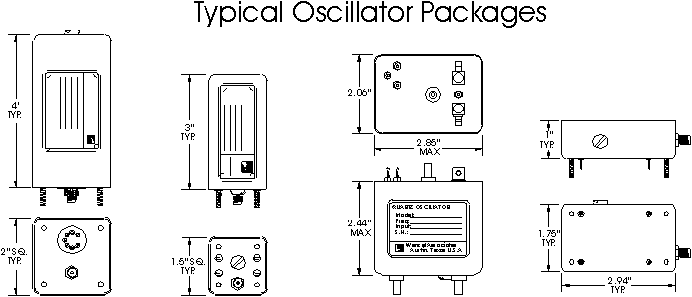Historically, the highest performance oscillators were packaged in cold-rolled steel cans approaching the size of a lunch box. Many of these designs were mechanical marvels filled with custom-made hardware surrounded by a large silvered Dewar flasks for insulation. Modern-day versions of these oscillators measure about 3 x 3 x 5″ and offer excellent long-term, short-term, and temperature stability. Insulation is often provided by a glass Dewar flask and some designs are fragile. A typical stability specification is 0.1 ppb for 24 hours for all causes, including temperature variations and aging.
Smaller, higher volume oven oscillators insulate the oven components with a foam clam-shell or hollowed-out cavity. The larger packages, typically 2 x 2 x 4″ or 2 x 2 x 3″, have sufficient room for thick foam walls and large oven structures. These ovens can easily accommodate the larger precision crystals, high quality mechanical tuning components, and older leaded components. The long can also leaves room for custom circuitry for special outputs, frequency multipliers, dividers, etc. Reduced-size versions of these oscillators have been available for several years but the power consumption is higher, perhaps requiring several watts at room temperature, and the short-term and temperature stability is degraded.
Wenzel’s “Small Fry” oscillator introduced in the early 1980s is essentially a miniaturized version of the high performance Dewar oscillators. The Small Fry measures 1.5 x 1.5 x 3″ and contains a tiny vacuum flask insulator. Power consumption is about one watt at room temperature despite the large oven structure, 20-turn frequency adjustor and large third-overtone SC-cut crystal. An even smaller Dewar insulated oscillator dubbed the “WAMO” for “Wenzel Associates Miniature Oscillator” measures only 1.3″ on all three sides. Surface-mount circuitry allows for such miniaturization with ordinary manufacturing techniques.
Surface-mount components have also allowed for the miniaturization of foam-insulated oven oscillators. An example is the new L.O. series from Wenzel Associates. A typical 100 MHz unit measures only 1.5 x 1.5 x 0.5″ and consumes onder 2 watts at room temperature. Surface-mount miniaturization allows this unit to have a high performance voltage regulator and oven controller, 20-turn tuning control, over 13 dBm output, and “ultra-low” phase noise.
As the oscillator packages shrink the materials used are changing. In the past the typical oscillator package was a deep-drawn cold-rolled steel can with nickel plating or paint. Newer oscillators are packaged in corrosion-resistant alloys to avoid the costly plating or painting steps. Oven oscillator performance is in much higher demand than in years past and the packaging is reflecting the need for higher volume production at lower cost.
Re: J.J. Orley
Connectors Virtually every style of RF connector that is manufactured has found its way onto crystal oscillators. The same style of connector is often used throughout a system and, since many are microwave systems, it is common to encounter SMA, SMB, SMC, MCX and various miniature proprietary connectors. BNC and TNC connectors are also used on the larger oscillators. Many oscillators use ordinary pins for the RF output but harmonics might cause problems inside the system or cause problems meeting emissions testing standards. Power and other control or signal pins may be individual feed-through filters or arranged together on a filtered header or connector. Many low-cost oven oscillators are PCB mounted along with other RF or high-speed circuitry in a shielded compartment. In these applications the RF signal is simply brought out of the oscillator on another pin.
